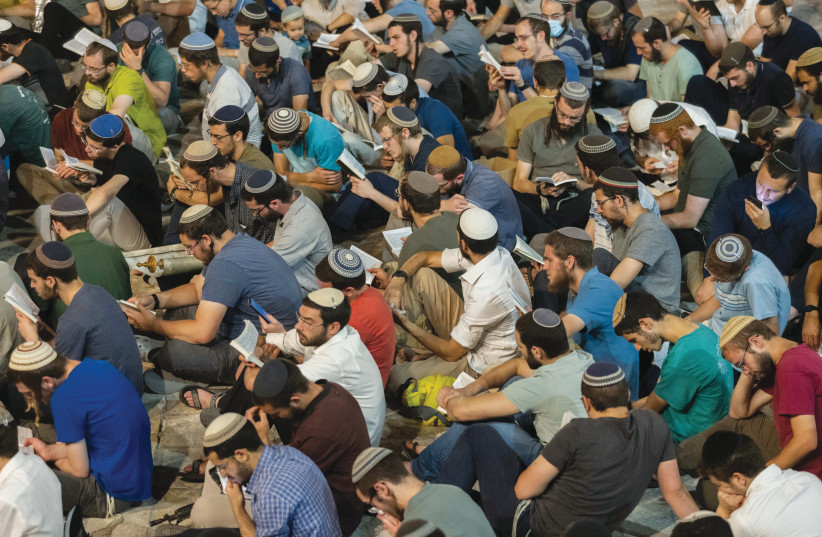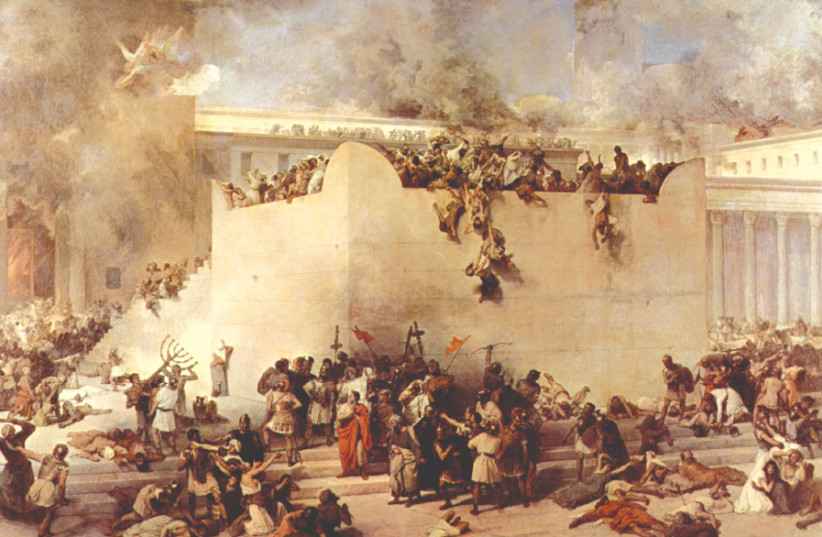Tisha Be’av: A revolution of consciousness
We face another round of Tisha Be’av longing for Temple rituals and political systems which, to some, seem alien. How can we reclaim authentic mourning?

With every passing year, our mourning for the lost Temple becomes more difficult. The disastrous fall of Jerusalem, and the derailment of Jewish history, occurred 2,000 years ago. As the people of memory, we excel in commemorating past national milestones. Recalling past events through ritual is a foundational aspect of our national identity. However, unlike commemorating a day, authentic mourning requires actual sadness, and it is hard to suffer genuine woe about events so far in the rear-view mirror.
Additionally, not only have thousands of years passed, but our society has dramatically advanced, bearing little resemblance to the ancient world. We are governed by enlightened democracies, thrive in progressive free-market economies, are privileged to have widespread education, and enjoy advanced medical care. The world of Judea and Jerusalem, and of Romans and Persians, appears yellowed and dated.
This gap between modernity and antiquity tests religious life in general. We delicately balance between our embrace of a modern world far superior to the ancient one, and our deference to the authority and traditions of past generations. While this gap between modernity and antiquity challenges religion, it severely muffles grief over a lost world which, to some, feels inferior and obsolete.
Furthermore, not only do we inhabit a changed world, but we also live with stark cultural dissonances. Central features of the classic Jewish world, whose loss we lament and whose restoration we pray for, feel foreign and even repulsive to modern sensibilities.
There are differing traditions about our messianic future. Some versions anticipate an apocalyptic overhaul, replacing our current condition with an entirely different state of affairs. Other messianic narratives are more evolutionary, envisioning the preservation of the current condition while wars and strife abate.
 ‘THE DESTRUCTION of the Temple of Jerusalem,’ Francesco Hayez, 1867 (credit: Wikimedia Commons)
‘THE DESTRUCTION of the Temple of Jerusalem,’ Francesco Hayez, 1867 (credit: Wikimedia Commons)Despite important differences, both messianic versions foresee the rebuilding of the Temple and the renewal of sacrifices. Modern culture is appalled by the thought of blood rituals and of animal sacrifices. To the modern imagination, these grisly images feel grotesque, not glorious.
Likewise, all messianic versions predict the restoration of the Jewish monarchy. It took humanity thousands of years to escape the tyranny of abusive monarchs who repressed human liberty and bled their countries dry to gratify their own base desires. In the past century, we beheld the horrors of totalitarianism, as dictators wreaked havoc upon innocent populations and butchered their own countrymen.
Modernity views the institution of monarchy, which we fervently pray for, as something horrifying. These cultural dissonances create attitudinal barriers that impede heartfelt mourning for the Temple and confuse us as we pray for its restoration.
As if all this weren’t challenging enough, our return to Jewish statehood and sovereignty further confounds our ability to grieve over past tragedies. Thankfully, we no longer face the rabid and violent antisemitism that plagued us throughout our exile. During exile, the brutal violence that terrorized us also served as a constant reminder of our lost status and our lost national fortune. No longer facing this aggression, it is harder for us to feel the pain of Jewish suffering and more difficult to grieve over lost destiny.
On top of all this, many religious Jews view our return to Israel as the inception of a broader redemptive process. Facing a future of optimism and opportunity, we feel gratified to live in an era of historical reawakening. Despite the fact that many hopes have yet to materialize, our collective giddiness over this historical awakening dulls our grief and dries our tears.
So, we face another round of Tisha Be’av struggling to evoke authentic mourning. We face another round of Tisha Be’av longing for Temple rituals and political systems which, to some, seem alien. How can we reclaim authentic mourning, and how can we inspirit genuine longing?
Tracing it back
Despite our triumphs, we continue to wrestle with many frustrating obstacles. By tracing these hurdles back to Jewish exile, we better incorporate these challenges into the tragic legacy of Tisha Be’av.
Though ruthless antisemitism has been curbed, we still face seething hostility and international opposition to our settlement of Israel. Repeatedly, our license and historical rights to our own homeland are being questioned. We have returned to a region which we haven’t inhabited for close to 2,000 years.
While we were absent, other empires and other races occupied this land. Though none were successful in establishing permanent empires, we were still not present to uphold our natural rights. Though the current struggle appears to be a geopolitical clash over occupied lands, it is, in truth, a historical struggle to reclaim an ancient homeland that we ourselves abandoned. We caused our own eviction from Jerusalem, and our current conflict traces back to that dark time in history.
Likewise, the widespread civil strife that has afflicted our country can be traced back to Tisha Be’av. During our extended exile, we lived apart, scattered across time and space. We are now returning, but as different ethnicities with varying religious levels and diverse political inclinations. We have no track record of living together as one cooperative family.
For the first 75 years of our state, the acute dangers we faced united us and muted these differences. Now that, thankfully, these dangers have receded, the genie has been let out of the bottle, and our social fabric is fraying. The upsetting social conflicts of the past few months should also be traced back to the day we left Jerusalem. We are gradually repairing the fallout of that tragic day.
Revolution of consciousness
Alternatively, we can also long for national institutions we don’t yet fully identify with. The messianic era will bring great revolutions. Wars will abate, prosperity will abound, and suffering will vanish. Not only will the world change, but attitudes will also shift.
The world will turn back to religion and will improve its moral standards of behavior. Divine events and human history will conspire to create a revolution of consciousness. Humanity will search for God, acknowledge the Jewish people as divine ambassadors, and look to Jerusalem for divine input and moral instruction.
To the average bystander, this vision seems preposterous. Our deeply secularized world isn’t veering toward religious resurgence nor are moral standards steadily improving. Classic value systems are crumbling all around us, and human identity is in full-blown crisis. There is no logic suggesting a return to God or a moral renaissance.
However, people of faith do not calculate the future with logic but imagine it with bold faith. We expect not only political and economic revolutions but also a revolution of consciousness.
JUST AS we expect a revolution of consciousness in others, can we also imagine the same adjustment within ourselves? Can we believe that, despite our current antipathy to animal sacrifices, one day our attitudes will shift?
Are we too overconfident in contemporary cultural attitudes that we are utterly incapable of even imagining a different mindset? Though we conduct our lives with current cultural norms, are we honest and humble enough to concede that our attitudes will be adjusted?
We believe in a revolution of consciousness in the broader non-religious world around us. Can we also believe in a similar revolution in our religious attitudes? Can we pray for something we don’t currently desire but hope to, one day, better appreciate? ■
The writer is a rabbi at Yeshivat Har Etzion/Gush, a hesder yeshiva. He has rabbinic ordination and holds a BA in computer science from Yeshiva University, as well as an MA in English literature from the City University of New York.
Content retrieved from: https://www.jpost.com/judaism/article-751821.